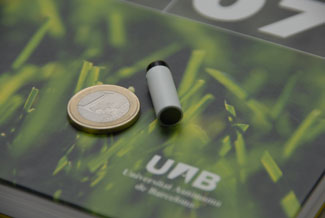A new portable biosensor detects traces of contaminants in food

The agricultural use of atrazine, and other herbicides based on a chemical substance called triazine, often causes contamination both of underground water and overground water. For this reason food safety agencies have established control measures to prevent these pesticides entering the food chain. Similarly, antibiotics used to treat bacterial infections in domestic animals, such as the case of sulphanilamides in cattle, and even those used to improve growth in farm animals, may contaminate food and be harmful for people. The European Community has established upper limits for the presence of traces of pesticides and antibiotics in food, but the control of these limits is carried out in laboratories with expensive, slow and bulky equipment.
The sensor developed by scientists at the UAB and the CSIC will allow the detection of doses of atrazine at levels of 0.006 micrograms per litre, much lower than the maximum concentrations allowed by European regulations (0.1 micrograms per litre), and this can be done more quickly and cheaply than is the case of the chromatographs which are used today in food safety laboratories. As regards the detection of antibiotics, the sensor has a sensitivity of 1 microgram per litre for whole milk, while the legislation allows a maximum of 100 micrograms per litre.
Due to the ease of use of this sensor and its portability, the technique can be used in situ for quantitative analysis of the presence of atrazine, as well as that of other herbicides, in food and water samples outside the laboratory. The sensor can be easily prepared by means of a process that can be extended on an industrial scale to allow the manufacture of large quantities at a very low cost, and may even be made for personal, disposable use .
The chemical mechanism to detect contaminants in a sample is very similar to that used by the immune system to identify a virus or bacteria in the body. The organism attacks an infection by generating antibodies which hook onto, for example, a specific type of virus. Hence the virus is identified and may be eliminated. In the case of the sensors, specific antibodies for atrazine have been used (in the case of pesticides) and for sulphanilamide (in the case of identifying antibiotics). Once the antibodies hook onto the contaminating particles they are attracted to the surface of a transductor which converts the contact with the antibodies into electrical signals. By measuring these electric signals the device can determine the concentration of contaminants in the sample.
According to Isabel Pividori, researcher at the UAB Sensors and Biosensors Group and co-director of the study, "due to their characteristics, such as their ability to carry out measurements in the field, the biosensors are analytical tools which have numerous applications in the agro food industry, and can be used as an alarm for the rapid detection of 'risk' of contamination in practices based on Risk and Critical Control Point Analysis".
The research has been undertaken jointly by the professor of the Department of Chemistry, Salvador Alegret and the doctoral student Emanuela Zacco, and has counted on the participation of the Applied Molecular Receptor Group at the Institute of Chemical and Environmental Research in (CSIC), headed by Maria Pilar Marco. The results have recently been published in the journals Analytical Chemistry and Biosensors and Bioelectronics.
References
E.Zacco, R. Galve, M.P. Marco, S. Alegret, M.I.Pividori, "Electrochemical biosensing of pesticide residues based on affinity biocomposite platforms", Biosensors and bioelectronics 22 (2007) 1707-1715 E.Zacco, J. Adrian, R. Galve, M.P. Marco, S. Alegret, M.I.Pividori,"Electrochemical magneto immunosensing of antibiotic residues in milk", Biosensors and bioelectronics 22 (2007) 2184-2191 E.Zacco, M.I.Pividori, S. Alegret, R. Galve, M.P. Marco, "Electrochemical magnetoimmunosensing strategy for the detection of pesticides residues", Anal Chem. 2006, 78, 1780-1788

